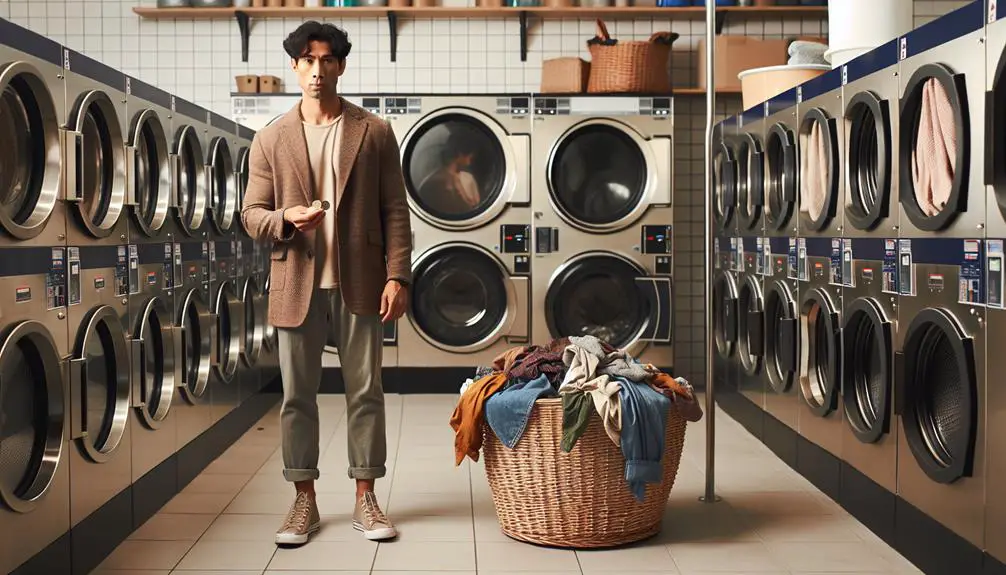By chance, have you ever wondered how much laundromats really cost?
It's intriguing to explore the various factors that influence these expenses. From location to the type of equipment used, the numbers can vary significantly.
But before diving into the specifics, let's uncover some surprising insights that might change the way you view this everyday chore.
Table of Contents
Key Takeaways
- Laundromat costs range from $2 to $4 per load, impacting profitability.
- Commercial washers cost $800 to $2,600 each, affecting initial investment.
- Business insurance ranges from $350 to $750 annually, adding to operational expenses.
- Location near customers is crucial for success, with 87% residing within a mile.
Factors Influencing Laundromat Operating Costs
When running a laundromat, various factors such as electricity consumption, water usage, and the cost of laundry supplies significantly impact the overall operating costs. In terms of business costs, one major expense stems from the operation of laundry machines. For instance, electricity consumption can amount to approximately $120 annually per machine. This cost isn't insignificant and can add up quickly, especially for laundromats with multiple machines.
Moreover, water usage is another crucial aspect that affects operating expenses. With an average of 41 gallons per load, water costs can become a substantial part of the overall expenses. Additionally, the cost of laundry supplies like detergent and fabric softener also plays a role in determining the profitability of the business.
Therefore, managing these factors efficiently is essential to keep operating costs in check and maximize the profitability of the laundromat.
Breakdown of Laundry Utility Expenses
To understand the breakdown of laundry utility expenses, it's crucial to analyze the specific costs involved in running a laundromat efficiently. When considering the utility expenses of a laundromat, key factors include water and electricity usage, laundry supply costs, and the efficiency of machines. High-efficiency machines play a significant role in reducing electricity consumption, with the average cost amounting to around $120 annually. Water consumption is also vital, averaging 41 gallons per load. Additionally, laundry supply costs can impact overall expenses significantly and should be carefully managed to ensure profitability. Implementing strategies such as using cold water, air drying clothes, and washing full loads can further reduce energy and water usage, ultimately decreasing utility expenses. By investing in high-efficiency machines and adopting environmentally-friendly laundry practices, laundromat owners can effectively manage and lower their utility costs while maintaining operational efficiency.
| Utility Expenses | Average Cost | Impact |
|---|---|---|
| Electricity | $120 annually | High |
| Water | 41 gallons/load | Significant |
| Laundry Supplies | Varies | Substantial |
Cost Analysis: Home Vs. Laundromat Laundry
When comparing the costs between doing laundry at home and using a laundromat, three key points come into play:
cost efficiency, time savings, and convenience.
These factors play a crucial role in determining which option is more economical and practical for individuals.
Cost Efficiency Comparison
Exploring the cost efficiency between doing laundry at home versus at a laundromat reveals important factors impacting overall expenses. Home laundry involves an average cost of $1.37 per load, while laundromats can range from $2 to $4 per load, with recent data showing an average of $3 per load.
When considering cost efficiency, we must account for electricity consumption, which amounts to about $120 annually for home laundry. Both home and laundromat laundry costs can be reduced by utilizing high-efficiency machines and adjusting laundry habits. These adjustments can positively impact business costs and overall expenses, making it crucial to evaluate the most cost-effective option based on load size, frequency, and convenience.
Time Savings Consideration
Making the switch to a laundromat not only saves on time but also offers a convenient and efficient laundry solution. Time savings are significant when comparing home laundry to laundromat visits. Home laundry can consume multiple hours weekly, while laundromats allow for quick completion of loads.
The efficiency of laundromats is enhanced by the availability of multiple machines, enabling simultaneous use and reducing overall laundry time. Completing several loads at once in a laundromat can greatly impact time savings compared to home laundry.
For those seeking to optimize their time and streamline the laundry process, laundromats present a cost-effective solution with notable time-saving benefits. The convenience and efficiency of laundromats make them a practical choice for busy individuals looking to simplify their laundry routine.
Convenience Factor Analysis
Considering the convenience and cost factors of home versus laundromat laundry, it's essential to analyze the overall benefits to determine the most suitable option for your needs. Laundromats typically charge between $2 to $4 per load, offering convenience, especially for those without laundry facilities at home.
On the other hand, the cost per load for home laundry averages around $1.37, making it slightly more cost-effective than laundromats. Recent data indicating an increase in laundromat costs to about $3 per load has impacted the overall cost comparison.
When deciding between home and laundromat laundry for cost-effectiveness, factors such as convenience, availability, load size/type, water and electricity usage, supply costs, and personal preferences should all be taken into consideration.
Essential Equipment Investment for Laundromats
When setting up a laundromat, one essential aspect to consider is the investment required for acquiring commercial washers, with each unit costing between $800 and $2,600. These commercial washers are the backbone of the business, ensuring that customers have access to quality laundry facilities. It's important to note that the lifespan of these machines typically ranges from 10 to 15 years, making them a durable investment for your business costs.
Additionally, implementing card reader systems in laundromats can require a significant upfront investment of $40,000 to $80,000. While this may seem steep, it offers convenience to customers who prefer cashless transactions. These systems not only streamline operations but also cater to the evolving payment preferences of modern consumers.
To support the smooth functioning of your laundromat, you'll also need other supplies like laundry carts, cleaning equipment, signage, and more. These items are vital for day-to-day operations and ensuring a positive customer experience.
Understanding Business Insurance Costs
Business insurance costs for laundromats typically range from $350 to $750 annually for general liability coverage. When considering insurance for your laundromat, it's essential to understand the factors that influence premium costs. Here are some key points to keep in mind:
- Coverage Types: The cost of business insurance can vary depending on the types of coverage you choose. General liability insurance is a common starting point, but you may also need property insurance, commercial auto insurance, or other specialized coverage based on your specific needs.
- Extent of Protection: The level of protection you require for your laundromat will impact the premium costs. Higher coverage limits and additional protections against specific risks will typically result in higher premiums.
- Workers' Compensation: In addition to general liability coverage, laundromat owners may need to factor in the costs of workers' compensation insurance. This coverage helps protect employees in case of work-related injuries or illnesses and is often mandatory in many states.
Understanding these aspects of business insurance is crucial for managing costs effectively and ensuring comprehensive coverage for your laundromat.
Effective Marketing Strategies for Laundromats
To effectively attract customers and maximize revenue for your laundromat, allocating a percentage of gross revenue to strategic marketing efforts is crucial. Setting aside 7% to 8% of your earnings for marketing can significantly impact your business's success. Developing a personalized marketing plan tailored to your target audience and promoting your services through various mediums such as social media, local advertising, and community events can help increase foot traffic and customer loyalty.
Moreover, offering additional services like wash-and-fold or laundry delivery can differentiate your laundromat from competitors and create new revenue streams. Ensuring the efficient management of machine maintenance and repairs is also essential for operational success. Regular maintenance checks and prompt repairs can prevent unexpected downtimes and maintain customer satisfaction.
Creating a clean, welcoming environment with amenities like vending machines can further enhance the overall customer experience and encourage repeat visits. By focusing on these marketing efforts, additional services, and efficiently managing machine maintenance, you can elevate your laundromat's visibility and profitability in the market.
Financing Options for Laundromat Start-ups
When starting a laundromat business, understanding different funding sources and the loan application process is crucial.
It's important to have a solid business plan showcasing profitability and industry experience to secure financing.
Collateral might also be necessary, so consulting with financial institutions to meet specific requirements is key to getting the start-up funds needed.
Funding Sources
When exploring financing options for Laundromat start-ups, assessing financial stability and creditworthiness becomes essential. Securing funding for a laundromat business demands a solid business plan outlining profitability to attract potential investors or lenders. Additionally, having collateral could increase the likelihood of obtaining financing for covering startup costs. Industry experience in the laundry business can also play a vital role in convincing financial institutions to support your venture. Consultation with financial institutions is crucial to comprehend their specific requirements and tailor your funding approach accordingly.
Funding Sources:
- Business Plan: A detailed plan demonstrating profitability is crucial for securing funding.
- Collateral: Collateral may be needed to secure financing for opening a laundromat.
- Industry Experience: Experience in the laundry business can enhance chances of obtaining financing.
Loan Application Process
Navigating the loan application process for laundromat start-ups involves showcasing financial stability, creditworthiness, and a detailed business plan demonstrating profitability. Lenders typically require evidence of stable finances and a solid credit history to consider loan applications.
Moreover, a well-thought-out business plan outlining revenue projections, expenses, and market analysis is crucial to convince lenders of the laundromat's viability. Collateral may also be necessary to secure the loan.
Additionally, having experience in the laundry industry can bolster your credibility and increase your chances of loan approval. It's advisable to research and understand the specific requirements of financial institutions offering loans for laundromat start-ups to streamline the application process and improve your chances of obtaining financing.
Comparing New Vs. Existing Laundromat Costs
In comparing the costs of new and existing laundromats, one must carefully consider factors such as equipment condition, location, and lease details to make an informed decision. When weighing the options, here are key points to keep in mind:
- Cost Variance: Existing laundromats typically cost four to six times the annual net revenue, whereas new laundromat startup costs range from $200,000 to $500,000.
- Advantages of Existing Businesses: Buying an existing laundromat may offer efficiency and customer loyalty advantages, despite the higher upfront cost due to the established customer base and operational setup.
- Equipment Condition Impact: Existing laundromats with machines in good condition may be pricier initially; however, they can save on renovation expenses, affecting the overall cost comparison between new and existing setups.
Considering these factors can help in determining the most cost-effective option when venturing into the laundromat business.
Financial Planning for Laundromat Business
To effectively establish a successful laundromat business, careful financial planning is essential to ensure proper budgeting for equipment, supplies, utilities, maintenance, and insurance. When considering the initial investment required for a laundromat, it's crucial to account for the costs of equipment, which can vary based on the size and capacity needed. Financial planning should also encompass ongoing expenses like utilities and maintenance to keep the business running smoothly. Below is a breakdown of some key financial aspects to consider:
| Financial Aspect | Description | Importance |
|---|---|---|
| Initial Investment | Estimate costs for equipment and property | Essential |
| Equipment | Washers, dryers, change machines, etc. | Vital for operation |
| Financial Planning | Budget for ongoing expenses and growth | Ensure sustainability |
Location Considerations for Laundromats
When setting up a laundromat, the location is key. Being close to where customers live can boost traffic and convenience.
It's also crucial to assess the competition and accessibility of the area to ensure success.
Proximity to Customers
Considering the importance of proximity to customers for laundromats, selecting a location near residential areas or apartment buildings is key to attracting and retaining a loyal clientele. When choosing a location for a laundromat, it's crucial to keep these points in mind:
- 87% of customers reside within a mile: By positioning the laundromat near residential areas, you increase accessibility and convenience for the majority of your potential customer base.
- Enhanced customer convenience near apartment buildings: Proximity to apartments can lead to higher foot traffic and increased patronage due to the convenience factor.
- Market research for optimal location: Conducting thorough market research helps in identifying areas with high demand and less competition, aiding in selecting the best location for a profitable laundromat.
Accessibility of Location
A key factor in the success of a laundromat business is the accessibility of its location to apartment buildings and residential areas. Conducting thorough market research helps in understanding the demand and competition in a specific area, guiding the decision on where to set up the laundromat.
Additionally, analyzing commercial space rental costs is crucial, as it directly impacts the monthly expenses of the business. Strategic market analysis plays a vital role in identifying the most profitable location for a laundromat. Choosing a site with high foot traffic and visibility can significantly enhance the business's profitability.
Competitors in Area
To build a thriving laundromat business, understanding the competitive landscape in the area is essential, including the proximity and offerings of other laundromat businesses. When assessing competitors in the area, consider the following:
- Market Saturation: Determine how many laundromats already exist in the vicinity to gauge the level of competition and potential customer demand.
- Competitor Pricing: Analyze the pricing strategies of rival laundromats to ensure your rates are competitive and attractive to customers.
- Differentiation: Identify what sets your laundromat apart from competitors in terms of services, amenities, or customer experience to attract and retain a loyal customer base.
Frequently Asked Questions
How Much Do Most Laundromats Charge?
Pricing for most laundromats varies, but it's typically between $2 to $4 per load. Factors like location and amenities influence the cost. Bulk pricing and discounts may be available for frequent customers, making laundry more affordable.
How Much Money Do You Need for a Laundromat?
To start a laundromat, you need substantial funds for equipment, location, and ongoing expenses. It's crucial to research costs thoroughly and plan for unexpected expenses. Investing wisely and managing finances effectively are key to success.
How Much Does It Cost to Open up a Laundromat?
Well, opening a laundromat can be a hefty investment. Costs vary based on location, existing infrastructure, and equipment. It's crucial to research thoroughly and plan wisely to ensure a successful venture.
Is a Laundromat Worth Owning?
Owning a laundromat is worth it for me; the high ROI, potential for substantial income, and tax benefits make it a lucrative investment. Plus, the industry's high success rate offers a promising future.
- Why Is Red Velvet Not Red? - April 25, 2024
- How Do You Describe Velvet Fabric? - April 25, 2024
- How Strong Is Velvet? - April 25, 2024








